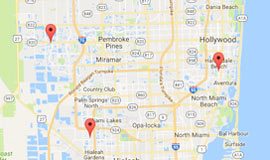A pulled groin muscle can happen suddenly and can’t be ignored.
Doctors call them sports hernias. The media calls them groin pulls. Whatever name it goes by, it’s a familiar item on the injured list in sports that involve abrupt twisting movements or changes of direction, like soccer, football and ice hockey.

In fact, a torn groin muscle might have cost the Tampa Bay Lightning the Stanley Cup this year.
After the championship was awarded to Chicago, we learned that goaltender Ben Bishop had been playing with a groin injury.
He sat out game 4, and was brought back for game 5. But playing through pain only earned him the loss that ended the team’s stellar season.
Unfortunately, there wasn’t much that Tampa Bay sports medicine experts could do for Ben Bishop. Even if we treat aggressively to relieve pain and inflammation, a groin muscle needs time to heal— the one factor that Tampa Bay did not have available in the locker room.
Sports Medicine Clinics
Professional athletes and sports medicine specialists recognize a groin injury because they are ubiquitous. The weekend warrior may not be so quick to name this pain. (By the way, a sports hernia, called athletic pubalgia, is not the same as an abdominal hernia which is signaled by a bulge in the lower belly. We’ll use the term groin pull, which is more common in the media.)
Briefly, here are some of the symptoms of a groin pull:
- pain or tenderness on the inside of the thigh
- pain when you try to draw your legs together
- pain when you bend your knee and raise your leg
- popping or snapping sensation when you incurred the injury, followed by severe pain
By now, you see the common denominator: pain. An old nickname for this injury is slap shot gut. This describes the violent twisting motion when a hockey player winds up for a slap shot. It could also describe the feeling of being hit by a shot in the groin area.
No joke: Without treatment, the injury can chase the athlete from the game, permanently.
While sports medicine professionals categorize groin pulls by the degree of severity, to an athlete there is only one relevant factor: How much practice and playing time will I miss, Doctor?

That depends on the rehab. They need to ice the inside thigh to reduce swelling and to wrap the thigh with a compression bandage.
We may also advise patients to take an anti-inflammatory drug (NSAID). We can get the patient started with stretching and strengthening exercises.
In these situations, pain is the coach. Any discomfort may signal that the patient is trying to do too much, too fast. Attempts to accelerate the rehab program may actually slow the healing process.
Conservative Treatments Are Usually Effective
To diagnose this type of injury, we’ll first find out what caused the pain. A physical exam will help us pinpoint the exact location. We may also observe while the patient tries to perform a sit-up. In the case of a pulled groin, these movements cause pain. We may also order imaging tests such as x-rays or MRI.
The trainer will emphasize that a groin muscle needs strengthening. But it’s important to work all muscle groups. If the thigh (adductors) are overly strong compared with the lower abdominals, twisting movements can cause an inguinal hernia (the kind with a visible bulge).
If the groin pull affects tendons that attach the thigh muscles (adductors) to the pubic bone, surgery may be necessary. There are several surgical options, including one called adductor tenotomy that is designed to relieve pain and allow a greater range of motion.
The take-home message is: Don’t wait. Call our clinic immediately. The sooner we see you, the sooner you can limp out the door and onto the road to recovery.











